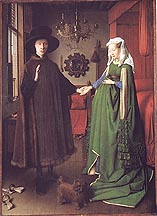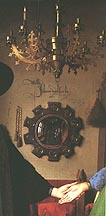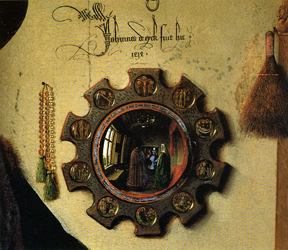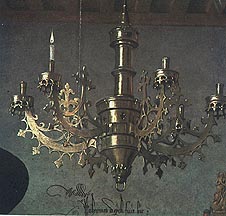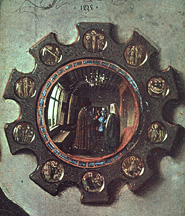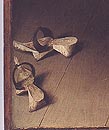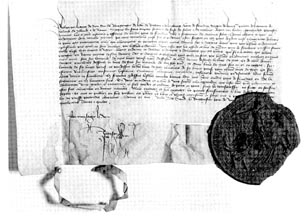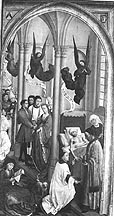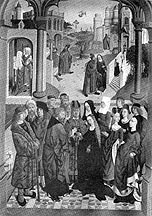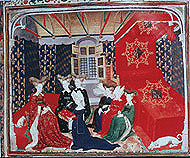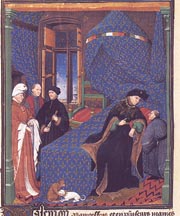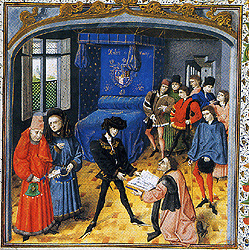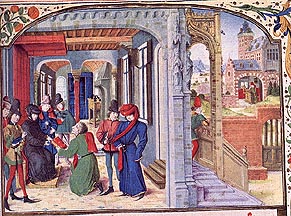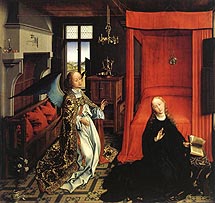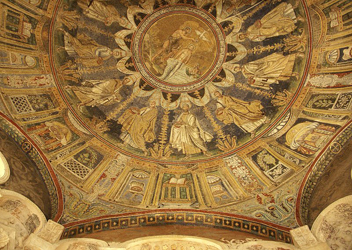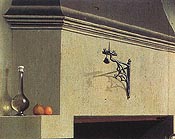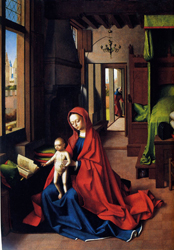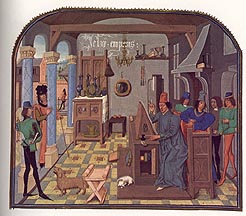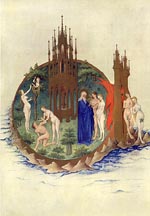Art Home | ARTH Courses | ARTH 200 Assignments | ARTH 214 Assignments
Jan Van Eyck's Arnolfini "Wedding" Portrait
| "...[M]eaning is neither found nor given, but that it takes shape arbitrarily, and that it is dependent upon associations and circumstances that scholars, artists, and viewers all bring to their engagement with paintings. It is not constructed by any one of them alone, although each of us is responsible for the orchestration of our own responses..." (Linda Seidel, Jan Van Eyck's Arnolfini Portrait: Stories of an Icon, Cambridge University Press, 1993, p. 14). |
Seidel reminds us in the quotation above that we should not understand our role as a passive one in which we simply reflect the "found" or "given" meaning of a work of art. Instead we need to take an active stance in relationship to the work and make or construct our own understanding of the meaning of a work of art. Seidel describes the role of the art historian as a narrator or story teller. This will be the stance I want us take in considering one of the major examples of Northern Renaissance art, Jan van Eyck's so-called Arnolfini Wedding Portrait.
In preparation for our class discussion, I want you to begin to create your own story about the painting. Consider the following gallery of details and try to explain how they fit into your story.
 |
|
The following excerpt is from Gardner's Art Through the Ages (pp. 576-578). It gives you a standard textbook account of the painting:
|
The intersection of the secular and religious in Flemish painting also surfaces in Jan van Eyck's double portrait Giovanni Arnolfini and His Bride. Van Eyck depicts the Lucca financier (who had established himself in Bruges as an agent of the Medici family) and his betrothed in a Flemish bedchamber that is simultaneously mundane and charged with the spiritual. As in the Mérode Altarpiece , almost every object portrayed conveys the event's sanctity, specifically, the holiness of matrimony. Arnolfini and his bride, Giovanna Cenami, hand in hand, take the marriage vows. The cast-aside clogs indicate this event is taking place on holy ground. The little dog symbolizes fidelity (the common canine name Fido originated from the Latin fido, "to trust"). Behind the pair, the curtains of the marriage bed have been opened. The bedpost's finial (crowning ornament) is a tiny statue of Saint Margaret, patron saint of childbirth. From the finial hangs a whisk broom, symbolic of domestic care. The oranges on the chest below the window may refer to fertility, and the all-seeing eye of God seems to be referred to twice. It is symbolized once by the single candle burning in the left rear holder of the ornate chandelier and again by the mirror, where viewers see the entire room reflected. The small medallions set into the mirror's frame show tiny scenes from the Passion of Christ and represent God's ever-present promise of salvation for the figures reflected on the mirror's convex surface. Van Eyck enhanced the documentary nature of this painting by exquisitely painting each object. He carefully distinguished textures and depicted the light from the window on the left reflecting off various surfaces. The artist augmented the scene's credibility by including the convex mirror, because viewers can see not only the principals, Arnolfini and his wife, but also two persons who look into the room through the door. One of these must be the artist himself, as the florid inscription above the mirror, "Johannes de Eyck fuit hic," announces he was present. The picture's purpose, then, seems to have been to record and sanctify this marriage. Although this has been the traditional interpretation of this image, some scholars recently have taken issue with this reading, suggesting that Arnolfini is conferring legal privileges on his wife to conduct business in his absence. Despite the lingering questions about the precise purpose of Giovanni Arnolfini and his Bride, the painting provides viewers today with great insight into both van Eyck's remarkable skill and Flemish life in the fifteenth century. |
Characters:
An early
sixteenth century inventory record apparently referring to the London painting
identifies the man in the painting as: "Arnoult-fin." This appears
to be a French version of the Italian name Arnolfini. There were several members
of this family from Lucca in northern 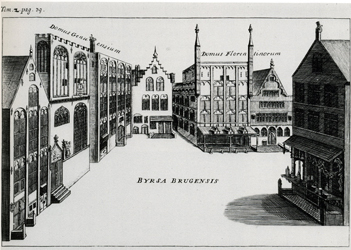 Europe during this period. In cities
like Paris and Bruges there were colonies of Italian merchant families during
this period. These families were actively engaged in the cloth industry and
other luxury materials catering to the needs of the nobility of northern Europe.
Many of these families also became involved with banking. Antonius Sanderus in the seventeenth century provides us with a view of the so-called Bourse or financial neighborhood in Bruges. The dominant buildings identified in the illustration are the Domus Florentinorum and the Domus Genuensium, or the Florentine and Genoese houses. The account records
of northern European princes have frequent entries recording loans given by
these Italian merchants to help support the need for liquid capital to support
the princely households. The Arnolfini referred to in the inventory is most
likely Giovanni di Arrigo Arnolfini who was born in Lucca about 1400. He appears
to have settled in Bruges by 1421. An entry in the Bruges Archives for July
1 of that year records that Giovanni made a large sale of silks and hats.
By at least 1423, Giovanni was engaged in transactions with the duke. There
was a large payment that year from the duke for a series of six tapestries
with scenes of Notre Dame. These were intended as a present to the Pope. There
is a record from 1446 listing a loan by Giovanni to Philip the Good. Perhaps
in exchange for the loan, Philip gave Giovanni the right to collect tariffs
on goods imported from England that entered through Gravelines for a period
of six years. This lucrative privilege was renewed for another six years.
In 1461, Giovanni became a councillor and chamberlain to the duke, and he
was knighted in 1462. Louis XI of France appointed Arnolfini a councillor
and Governor of Finance of Normandy. Giovanni died in 1472 and was buried
in the chapel of the Lucchese merchants at the Augustinian church in Bruges,
where he and his wife had endowed daily and anniversary masses in their name.
Europe during this period. In cities
like Paris and Bruges there were colonies of Italian merchant families during
this period. These families were actively engaged in the cloth industry and
other luxury materials catering to the needs of the nobility of northern Europe.
Many of these families also became involved with banking. Antonius Sanderus in the seventeenth century provides us with a view of the so-called Bourse or financial neighborhood in Bruges. The dominant buildings identified in the illustration are the Domus Florentinorum and the Domus Genuensium, or the Florentine and Genoese houses. The account records
of northern European princes have frequent entries recording loans given by
these Italian merchants to help support the need for liquid capital to support
the princely households. The Arnolfini referred to in the inventory is most
likely Giovanni di Arrigo Arnolfini who was born in Lucca about 1400. He appears
to have settled in Bruges by 1421. An entry in the Bruges Archives for July
1 of that year records that Giovanni made a large sale of silks and hats.
By at least 1423, Giovanni was engaged in transactions with the duke. There
was a large payment that year from the duke for a series of six tapestries
with scenes of Notre Dame. These were intended as a present to the Pope. There
is a record from 1446 listing a loan by Giovanni to Philip the Good. Perhaps
in exchange for the loan, Philip gave Giovanni the right to collect tariffs
on goods imported from England that entered through Gravelines for a period
of six years. This lucrative privilege was renewed for another six years.
In 1461, Giovanni became a councillor and chamberlain to the duke, and he
was knighted in 1462. Louis XI of France appointed Arnolfini a councillor
and Governor of Finance of Normandy. Giovanni died in 1472 and was buried
in the chapel of the Lucchese merchants at the Augustinian church in Bruges,
where he and his wife had endowed daily and anniversary masses in their name.
Giovanni married Giovanna Cenami the daughter of one of the most prominent Lucchese families established in northern Europe. Giovanna's grandmother was the niece of Dino Rapondi who along with his three brothers were close financial advisors and bankers for the Dukes Philip the Bold, John the Fearless, and Philip the Good of Burgundy at the end of the fourteenth century and the beginning of the fifteenth century. In 1432 when the last of the four Rapondi brothers died, Philip the Good had a special mass sung for them. Marriage alliances like that between the Cenami and Rapondi families were not private but public matters with the futures of the families' businesses inextricably linked. For Giovanni Arnolfini marrying into such a prominent family as the Cenamis was undoubtedly a significant boost to his financial fortunes. Unfortunately, we do not know which year they were married. So while not certain, the identification of the couple as Giovanni Arnolfini and Giovanna Cenami seems likely.
We know that the couple died childless. We should be cautious not to assume that they never had any children since they perhaps had children that predeceased them. At the same time there is no evidence that they did have children. We do have records of Giovanni having an extra-marital affair. In 1470, thus late in Giovanni's life, a woman took him to court to have returned to her jewelry he had given her. She also sought a pension and several houses that she had been promised.
An important part of our discussion about the Arnolfini portrait will be the idea of the unseen presence. Here this master of illusionistic representation calls attention to what cannot be shown directly, and that is God. There is probably also another unseen presence, and that is Philip the Good. It is unlikely that Arnolfinis or the Cenamis approached Jan van Eyck directly to paint the double portrait. Since Jan van Eyck was the court painter for Philip the Good, the Arnolfinis or the Cenamis would have at least needed the duke's permission to have van Eyck to do the painting. Jan's signature documents his role as witness to the event, and as a member of the ducal court, van Eyck was likely serving as the duke's representative. Thus his signature carries with it both personal and ducal sanction. Jean Wilson has taken this another step and understood the painting as a gift of Philip the Good to the couple (Painting in Bruges at the Close of the Middle Ages, p. 64). The painting can be seen to attest to the Arnolfini's membership in the household of the duke.
A Wedding Portrait?
While most scholars agree that the painting depicts Giovanni Arnolfini and Giovanna Cenami, Erwin Panofsky's assumption that the painting is a wedding portrait has been called into question. Compare the Arnolfini painting to the following works:
|
Right panel of Rogier van der Weyden's Altarpiece of the Seven Sacraments, painted for Jean Chevrot. |
Whether this is a wedding portrait or not it is important to see the painting in the context of the social and institutional attitudes towards marriage. Consult the excerpts from Dale Kent's essay "Women in Renaissance Florence." While not dealing with the Netherlands, the article is still relevant. Remember that the Arnolfinis and Cenamis come from Lucca which is very close to Florence.
Is she or isn't she?
I have never taught the Arnolfini Portrait without a student asking the question whether she is pregnant. Compare the dress worn by Giovanna Cenami to that worn by St. Catherine on the right wing of the Dresden triptych:
Images of Bedrooms:
|
Jean Miélot presenting his translation of the Traité sur l'Oraison Dominicale to Philip the Good. (see Burgundian Frontispieces) |
Author Presenting Book to the Duke of Burgundy Histoire de la conquete de la Toison d'Or (see Burgundian Frontispieces) |
Compare the Arnolfini bedchamber to that belonging to the wife of a merchant described by Christine de Pizan in her Livre de la trois vertus.
An Empty Throne?
| Dome of the Orthodox Baptistery in Ravenna decorated in the fifth century. Note the representation of the empty throne. | |
A Lost Work by Van Eyck?
To add an additional dimension to our discussion, consider the image below. It is a detail from Willem van Haecht's Archduke Albert Visits the Kunstkammer of Cornelius van der Geest. The detail shows an Eyckian painting of a woman at her toilet.
|
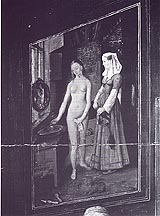
Detail of William van Haecht, Archduke Albert Visits the Kunstkammer of Cornelius van der Geest. |
Although the Eyckian work depicted in the Haecht painting has been subsequently lost, what is probably a copy of it is in the collection of the Fogg Art Museum:
The detail from the Haecht painting and the Fogg panel have been associated with the Italian humanist Fazio's description of a Van Eyck painting depicting a woman's bath. Fazio describes how van Eyck had represented the most intimate parts of a nude woman through the veil of fine linen and that the woman's back was reflected in a mirror.
The similarities of this lost work to the Arnolfini painting are unmistakeable. It seems likely that the lost work was a pendant to the London panel. How would you explain these two works as a pair?
Echoes of the Arnolfini Portrait:
Fall of Man from the Très riches heures, c. 1416
Limits of Interpretation and What is Our Share?
Linda Seidel in her Jan Van Eyck's Arnolfini Portrait: Stories of an Icon (Cambridge University Press, 1993, p. 129) includes the following useful quotation to frame our consideration about how far our interpretation can go:
| Few of us would disagree with the notion that viewers bring expectations of their own to an understanding of a work of art; few of us are likely to agree, however, about how little or how much autonomy a viewer enjoys in arriving at his or her own interpretation. For many, the range and nature of constraints on a given viewer's response are controversial matters. On one side are scholars, in the tradition of Panofsky, who limit the "beholder's share" by excluding from the interpretive process issues of daily life that inevitably attend it. Such individuals prefer to position art --its invention and appreciation-- above ordinary day-to-day encounters and to identify its sources and its purposes with what may be seen as privileged rather than prosaic claims. Audiences do not really matter much at all from this perspective. Other scholars, however, would argue that all meaning is lodged in a viewer's experience --though language-driven-- is not exclusively text-based, and that politics and sex have as much claim as religious or literary tracts in any interpretive strategy. Many scholars stand, knowingly or not, somewhere in between. |
